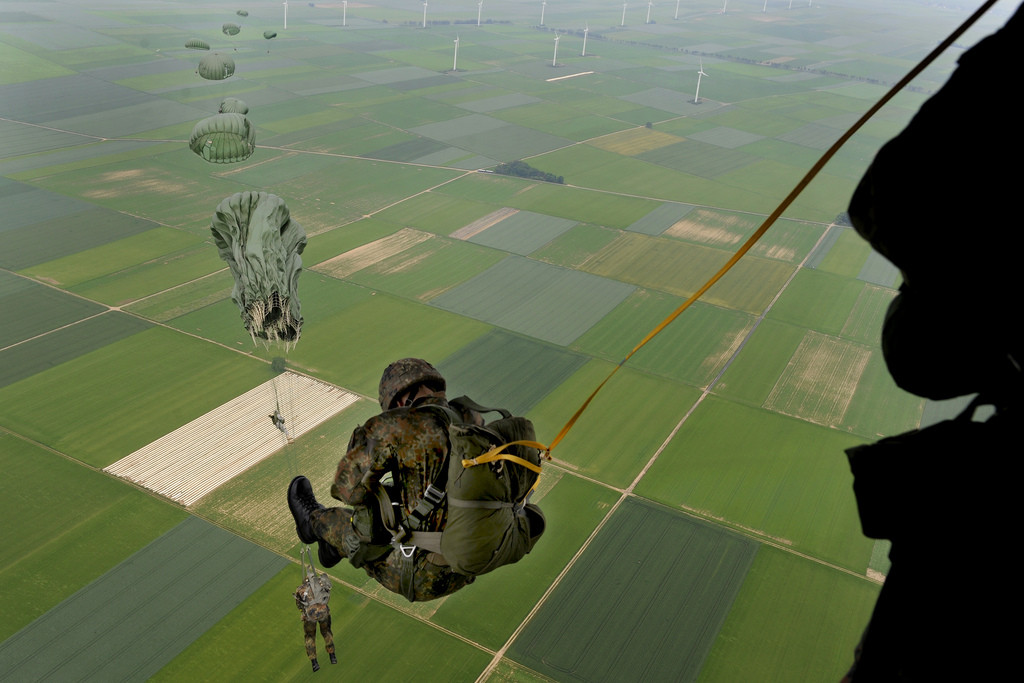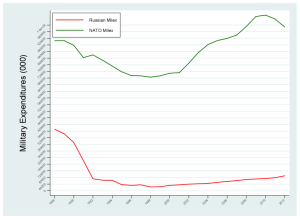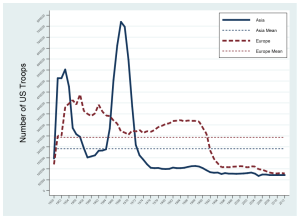NATO and Ukraine: Walking Familiar Ground

While in some ways the actors and scene are different, the basic dynamics of the Ukraine crisis are very old, not just for NATO, but for alliances in general. States seek to ensure their national security at the lowest cost possible. The costs in this case differ among NATO’s North American members, for whom the crisis fits in a larger global context; its Western European members, whose primary stake appears to be economic; and its Central and Eastern European members, whose security interests are most directly affected by Russia’s Ukrainian adventure.
Alliance members’ national interests often differ – crises highlight these differences. This variation in interests suggests that the wider effects of the Ukraine situation depend largely on the United States’ ability to strike a balance among reassuring friends, alarming Russia, and encouraging free riding among allies.
Virtually from NATO’s birth, a “Europeanist” current has favored the development of an autonomous European defense identity, separate and distinct from NATO, while an “Atlanticist” current has favored a more integrated transatlantic security community. These currents persist today. Early in NATO’s history, though, a third current, favoring accommodation with the Soviet Union for strategic (not ideological) reasons, emerged. If the United States was not fully invested in Europe’s defense, advocates like French Premier Leon Blum argued, a hobbled post-war Europe lacking in strategic depth could not hope to defend its territory alone and therefore should prepare to accommodate the USSR. The presence of this strategic “third way” made reassuring allies like Blum’s France a key task for the United States in NATO’s early years. Today, reassuring NATO’s Eastern allies is similarly important – varying interpretations of Russian assertiveness, combined with national and alliance capabilities, could lead them in either of the three directions outlined above.
Given this need for reassurance, the central problem for the United States remains: how to reassure allies without encouraging free riding? The Ukraine crisis highlights this dilemma, but is by no means its cause. The alliance political economy literature suggests that choices are limited: free riding is likely in an alliance in which one member disposes of significantly more resources than the rest, and the extent to which free riding occurs depends on the extent to which the benefits of collective security are excludable. This means that a world in which a relatively richer United States, whose investments in security generate benefits not just to the United States but, in an automatic way, to its allies, is a world in which free riding is likely.
This collective action argument is powerful, and its implications present a dilemma for the United States. The world described above is, in many ways, the kind of world the United States prefers – the United States has sought, and continues to seek, a leadership role in global politics. This leadership role implies costs, often assumed in the form of unequal burden sharing. Arthur Balfour captured this “hegemon’s security dilemma” neatly in his 1918 lament that “Every time I come to a discussion – at intervals of, say, five years – I find there is a new sphere which we have got to guard, which is supposed to protect the gateways of India. Those gateways are getting further and further from India, and I do not know how far west they are going to be brought.”
Before blaming allies for the costs of primacy identified by Balfour, their strategic perspectives merit serious consideration, along with Russia’s. In his now classic work on alliance formation, Stephen Walt highlights the role of threat in states’ alignment and alliance calculations. Recent empirical analysis suggests that, among NATO members, threats, understood in terms of material capabilities, proximity, and member state perceptions, also have a significant effect on defense investment as a proportion of GDP.
It is therefore worthwhile to consider the extent to which Russia’s behavior, interpreted in light of its capabilities, represents a threat to allies in varying geographic, economic, and domestic political situations. Russia is a different and mostly weaker actor than the Soviet Union was, for a great many reasons. In spite of increased investment of late and laudatory coverage of the skills of its special operations forces, Russia does not have the material resources or the military capabilities that the Soviet Union had, and the strategic balance in this area favors the U.S. and its allies (see graphic below). While defense investment does not translate directly into capabilities, the mismatch is worth noting – especially when policy prescriptions often conclude with admonitions to “beef up” Western defenses.

In many ways European NATO members are more capable than they were in 1988, having professionalized unwieldy conscript armies, and undertaken a decade of operations with the United States in Afghanistan, and multiple EU missions around the world. At the same time, NATO’s Western European allies face a less immediate threat from Russian aggression. NATO’s eastward expansion has created a new strategic depth for Western European allies, along with potential vulnerabilities for the alliance. Members like the Baltic States and Poland face a differing set of concerns, foremost among which is greater proximity to Russia.
So what tools can the United States use in trying to walk the tightrope of reassurance without inviting free-riding? And how are other actors likely to respond to the use of such tools?
A key tool the United States has at its disposal in crises is the dense network of institutions that it constructed in the post-Second World War period. Vladimir Putin has deftly exploited the inelegant way in which the U.S. has managed this institutional architecture since 2001, citing U.S. actions in Kosovo, Iraq, Afghanistan, Libya, and the Snowden Affair, contributing to an atmosphere in which allies are “united in feeling betrayed, misled, and not taken seriously.” While the ejection of Russia from the G-8 represented a small feat of consensus building given this environment, its effects appear limited at this stage. The extent to which the United States will be able to mobilize international norms and institutions to affect Russian behavior appears limited at this stage.
Another potential tool at the U.S.’s disposal is deploying additional forces to the region. Andrew Michta has effectively highlighted possible effects of the “Strategic Rebalance” toward Asia on European perceptions. But to what extent is such concern actually detrimental to U.S. policy objectives in the region, especially if more equitable burden sharing among NATO allies is among those objectives?
Indeed, in terms of U.S. military presence, most of any “pivot away” from Europe already took place in the 1990s (see graphic below). The effect of U.S. troop presence on policy alignment among European allies is also rather ambiguous, particularly since the end of the Cold War. In this context, small, symbolic deployments such as that of parts of the U.S. Army’s 173rd Airborne Brigade to Poland and the Baltic states align with the empirics of the recent past. But beyond such deployments, updated conceptualizations of conventional deterrence through implicit threats to impose costs associated with undesirable actions also merit considering. For example, are the United States or European allies willing to use, or threaten to use, the tools of unconventional warfare in Russia’s near abroad in order to impose such costs?

Perhaps because of the risks associated with any military escalation, NATO members have, to this point, favored economic sanctions against Russia. But this approach does not obviate burden sharing considerations – it merely shifts them to another arena. How can European states contribute in this arena?
Each of Europe’s largest states has access to different Russian vulnerabilities, and each has different vulnerabilities vis-à-vis Russia. While Germany has perhaps the most economic leverage with Russia, structural constraints and recent shifts in Germany’s domestic energy policy leave Europe’s leading economy dependent on Russian gas exports, and its domestic “Putinversteher” phenomenon is an additional constraint.
France, whose nuclear-powered energy sector is less vulnerable than Germany’s, is considering suspending a long-pending deal to sell Russia Mistral helicopter carriers. But powerful domestic constituencies in France push for such arms export deals – both because such deals support French jobs, and because they are crucial for the survival of France’s arms industry. Not only does France consider this an ‘industrie de souveraineté’, it is also critical to French and European capacity to carry high-end security burdens.
Finally, the City of London’s engagement with Russian enterprises creates a level of interdependence between the United Kingdom and Russia that offers both leverage and vulnerability. Just as with issues ranging from command structures to joint arms procurement, the ability of the “big three” to achieve compromise and consensus on the Russia issue is crucial to Europe’s ability to act in a concerted manner, whether using hard or soft power.
While Moscow can certainly impose costs on the West, in the medium to long-term and globally, the material balance of power favors the United States and its allies. Russia’s major advantage in the current crisis is that Ukraine is simply more central to Russia’s national security interests than it is to those of most NATO members. This is a tactical advantage, but a strategic weakness. Confounding military occupations is immeasurably easier – tactically, operationally, and strategically – than successfully executing them. As clever as it may appear, Putin’s legalistic maneuvering seems to be neither legal nor particularly effective in terms of shaping attitudes outside of Russia. Putin’s popularity in Russia could hardly be higher, and the marginal utility of increasing it appears limited.
Concerns abound, though, about an internal crisis faced by NATO – an alliance described by some as hollowed out after the Cold War, or unable to resolve classic burden sharing issues. Favored numbers are 75% (the portion of total NATO member military expenditures undertaken by the United States) and 2% (the target for military expenditures as a percentage of GDP that only the U.S., the UK, Estonia and Greece meet).
The reality of transatlantic burden sharing is far more complex, and likely effects of the current crisis on member state behavior are not uniform across the alliance. While the collective action approaches noted above effectively explain changes in aggregate military expenditures as a percentage of GDP, disaggregated expenditures tell a different story.
NATO classifies expenditures among four categories: equipment, infrastructure, personnel, and “other expenditures,” which crucially include “operations and maintenance expenditures [and] other R&D expenditures.” “Spillovers” from United States military expenditures have the expected effect on top line military expenditures, but those effects vary across the categories of disaggregated expenditures. For instance, the extent to which states articulate an Atlanticist, as opposed to a Europeanist, national security strategy is positively correlated with operating and equipment expenditures, and negatively correlated with personnel expenditures. Not all military expenditures are equal, and the tools outlined above have differing effects on each.
How, then, are these disaggregated measures of burden sharing likely to be affected by the Ukraine crisis? Commentators are right to highlight the role of U.S. behavior – to an extent. But consider the earlier discussion of the three strategic routes available to European states as the Cold War began in the late 1940s: an alliance that privileged transatlantic security arrangements, a focus on an autonomous European defense capability, or accommodation with the Soviet Union. The first required serious assurances from the U.S. The second required serious coordination among European allies, along with real improvements in capabilities. The third did not require much from the U.S. or from Europeans, other than a willingness to accept Soviet influence. 65 years ago, Europeans chose the first route.
Some commentators find that the unfolding crisis is likely to unnerve U.S. allies, and that such a phenomenon would have adverse effects on the alliance as a whole, as well as on U.S. relationships around the world. So how are allies, if inadequately reassured, likely to respond? Which of the three routes highlighted above are they most likely to take? The “third way” appears, at this stage, very unlikely. So are European allies more likely to seek to develop autonomous regional capabilities, or to strengthen ties with the U.S.? And which of these courses of action is preferable to the United States?
The resource allocation choice associated with strengthening ties with the U.S. would likely be to allocate more to expeditionary capabilities, equipment, and operations themselves, as suggested by the correlation between Atlanticist foreign policy orientations and increased expenditures in those areas. A state that was less confident of U.S. support would likely allocate more resources to equipment and personnel useful for territorial defense, perhaps even strengthening regional security architecture like Europe’s Common Security and Defense Policy.
Neither of these courses of action poses a serious risk for U.S. interests in Europe or elsewhere. As a decade of large footprint “out of area” operations winds down for both the U.S. and its NATO allies, the focus of burden sharing is likely to shift to enhancing Europe’s ability to secure itself and its neighborhood. If anything, the current crisis seems likely to help focus minds on this task.
Russia’s adventure in Ukraine is catastrophic for Ukraine and for many Ukrainians, and probably not very good for Russia. But it only poses a threat to NATO members to the extent to which Russia itself poses such a threat – which is limited. The Ukraine crisis should not threaten the United States’ relationship with its allies, or its ability to exercise influence globally. If anything, it presents opportunities for shifting NATO’s burden sharing arrangements in a way that is in the interest of both the United States and its European allies. As the United States navigates challenges posed by Russia’s assertive behavior in its near abroad, reassuring worried allies is important, but too much reassurance risks missing an opportunity to encourage European NATO members to carry a greater share of the alliance’s collective security burden.
Jordan Becker is an assistant professor of international relations at the United States Military Academy at West Point and a War on the Rocks contributor. The views expressed here are his own and do not reflect the positions of the U.S. Military Academy, the U.S. Army, or any part of the U.S. government.
Photo credit: The U.S. Army

